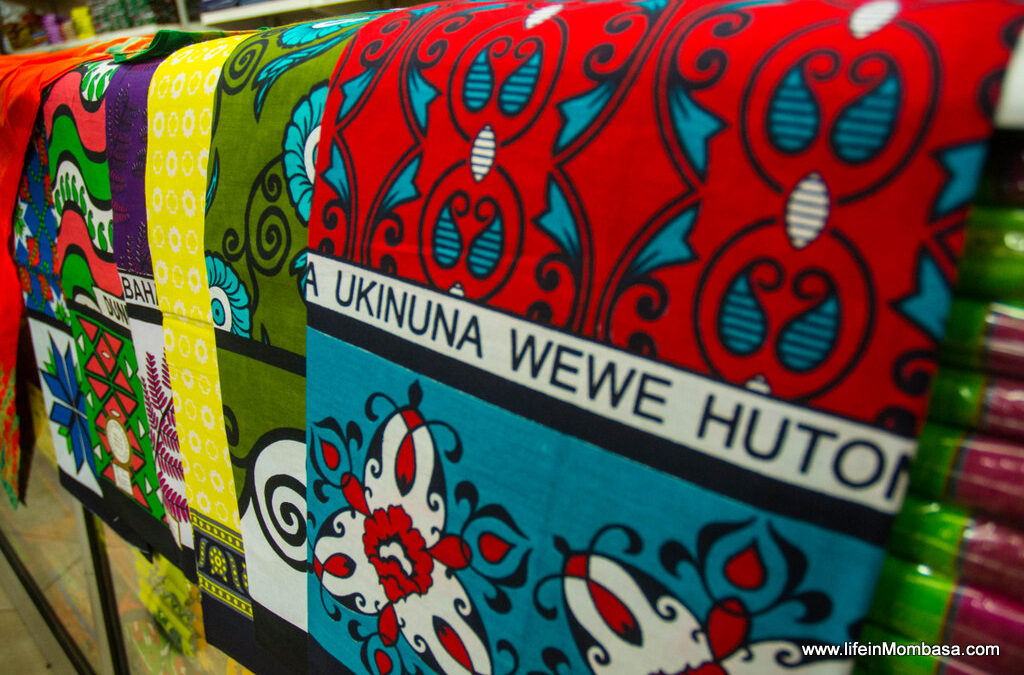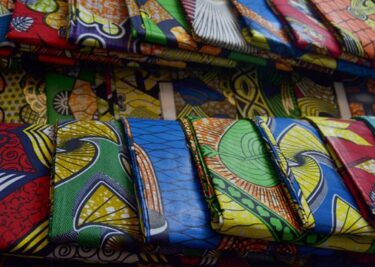The Visual Language of the Leso

Image Credit: Life in Mombasa
The vibrant and versatile leso, also known as kanga, has woven itself into the fabric of daily life for those living in Kenya and Tanzania. From use during significant life events like births, marriages, and funerals to everyday tasks, this rectangular piece of pure cotton textile with bold designs is an integral part of East African culture. Typically purchased or worn as a pair called a doti, the leso carries a rich history behind its creation.
The origin of the leso dates back to the early 18th century when Portuguese traders introduced square kerchiefs called lenco to the East African coast. Waswahili women ingeniously combined six pieces of this fabric to create the leso. Over time, this innovation evolved into a single unit of cloth that was reminiscent of the guinea fowl, which is also known in Kiswahili as kanga, due to its vibrant and eye-catching pattern. As the concept of the six-piece handkerchief became one cohesive cloth, merchants recognized its potential and began importing and selling them in their shops. These merchants brought not only lesos with European-inspired motifs like cars but also those with designs featuring local flora and fauna.
From Slavery to Empowerment: The Leso’s Symbolic Significance
With the abolition of slavery in East Africa in the late 1890s, the leso took on a new significance as it symbolized the integration of former slaves into society. Previously, slaves wore unbleached cotton cloth known as merikani. For freed slaves seeking to assert their new identities, the association of merikani with slavery led to a collective disdain for this textile, while the leso became a sought-after marker of freedom. Since store-bought lesos were often beyond the financial reach of these former slaves, they initially had to embellish their merikani clothes using various techniques like resist dying, block printing, and hand painting. This led to the spread of the leso’s popularity across the East African coast as it became a marker of prestige, identity and empowerment.
The introduction of roller-printing technology in the early 20th century facilitated mass production of lesos with factories first established in Asia and Europe, and from the 1960s, in Kenya and Tanzania.
The Anatomy and Communicative Genre of a Leso
Beyond its historical significance, the leso became a symbol of wealth and empowerment. Swahili women were advised to invest in them upon marriage as a form of insurance in case of a failed marriage. By trading their lesos for money or other goods, they could have a sense of financial security and independence. Swahili proverbs were later incorporated into lesos, adding an element of interpersonal communication, empowering the wearers – particularly the women – to speak out even when cultural norms dictated otherwise.
Supposedly, the fashion of incorporating Swahili sayings into lesos was initiated by a locally famous trader in Mombasa, Kaderdina Hajee Essak, also known as Abdulla. His leso designs, distinguished by the mark “K.H.E. – Mali ya Abdulla,” often included a proverb. At first, the sayings or slogans were printed in Arabic script then later in Roman letters. These proverbs, known as ujumbe or jina now form one of the three core aspects of leso design.
The two other important features of a leso include the wider outer border known as pindo and the central motif called mji. The pindo’s function is to provide support to the central design of leso. The mji occupies the most important area of the leso and together with the ujumbe, gives the leso design its popularity.

Image credit: Google Arts and Culture
Versatility in Use
Different communities along the Swahili Coast traditionally attributed specific meanings to leso colours. In some cultures, red and black lesos were worn during menstruation, while white ones symbolized the purity of the heart, often adorned during the full moon. In contemporary society, the leso’s versatility extends to various uses; it can serve as a clothing fabric, a baby wrapper, or even a postpartum recovery wrap, reflecting its multifunctionality in daily life.
Moreover, the leso has found a place in campaigns for various causes, used by governments and institutions to raise awareness on issues like malaria, health, education, and agriculture. With its power to convey messages when words fall short, the leso has become an indispensable tool in mobilizing people and creating awareness for development projects.
The Unstoppable Legacy of the Leso
Despite its affordability, the leso carries immense cultural value within Swahili communities. With its vibrant history, empowering symbolism, and multifaceted uses, the leso continues to be a beloved and cherished fabric, lending a voice of resistance and identity to those who wear it. The legacy of the leso as a symbol of unity, empowerment, and self-expression remains unstoppable and deeply rooted in the hearts and minds of Kenyans and Tanzanians alike.
#KeTextiles



